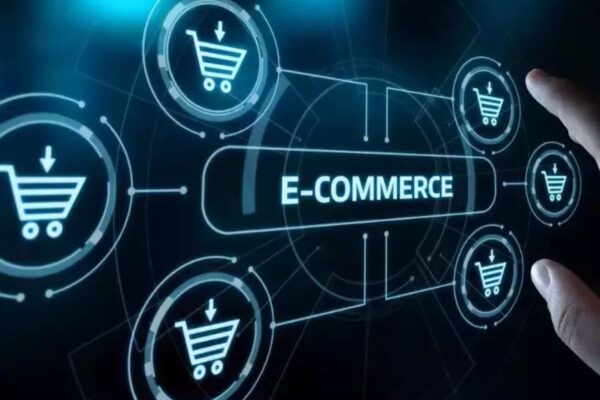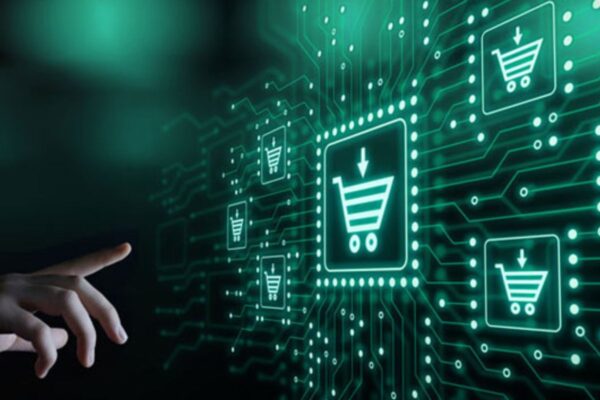Digital Commerce is the foreseeable future of Online Shopping

Digital commerce: the foreseeable future of Online Shopping
Have you marketed your goods and services on various online stores? If so, are you competent at effectively managing listings, prices, creatives, and content? The epidemic caused a change in consumer behaviour, with more people choosing the Digital Commerce service of internet retailers over traditional brick-and-mortar stores.
Since that time, online markets have emerged as the main forces behind the corporate expansion. But keeping track of your listings and maintaining several markets may be time- and effort-consuming.
The digital marketplace concept is a great method to cut down on the costs of running a physical store and the risk of keeping too much inventory. It offers a low-risk strategy for achieving a considerably more comprehensive audience.
How Online Marketplace will help you now and in future?

You shouldn’t let the difficulties listed above stop you from using the internet. Statistics show that by 2023, the US e-commerce business would have surpassed $1 trillion. India’s e-commerce sales increased from just $30 billion in 2020 to $84 billion in 2021. Businesses need to understand their potential for success in a digital environment.
- Convenience: With the marketplace concept, there are no longer any barriers for businesses to access their target clients. Large investments are no longer necessary for businesses to operate their physical storefronts and warehouses. Most marketplaces provide quick onboarding and help with promotion to increase sales.
- Global reach: With the aid of an online digital marketplace, your company can offer its goods and services anywhere in the globe. You can easily focus on a particular nation or demographic.
- Gain access to a sizable consumer base: Marketplaces provide a one-stop shop for all customers. A physical store’s selection and inventory cannot compare to those of an online marketplace. Because of the wide range of goods it provides, an online marketplace can thus reach a big customer base.
- Simple fulfilment of payments and logistics: Your marketplace takes care of all operational needs, including payments, shipping, refunds, returns, and product pickups. By increasing system efficiency, firms are free to concentrate on what they do best.
- Monitor the key performance indicators (KPIs): The majority of online marketplaces include dashboards that let you keep an eye on KPIs like revenue, sales, reach, and customer happiness. Most businesses cannot afford to separately acquire this capacity.
The difficulties of listing on numerous B2B markets
Even though B2B markets are the way of the future, managing your listing across many platforms presents several difficulties.
- The online B2B market is a dynamic environment where you frequently need to update your products, services, prices, and creatives. It is difficult to manually do this across numerous platforms.
- It is challenging to manage the agreements that have been agreed upon with several marketplaces and to provide customer assistance.
- A lack of backend technology can result in a lot of manual labour.
- Without technology, it is challenging to identify and deal with vendors who supply counterfeit goods and fraud.
Digital Commerce: Market management industry trends

The pandemic has changed how consumers shop and the ensuing market patterns are likely to have an impact on online marketplaces.
- Mobile shopping: Apps on smartphones account for almost 70% of all internet purchases. Businesses must ensure that clients have a fantastic shopping experience on desktops and mobile devices.
- Vertical marketplaces: These platforms link companies with clients who are part of a particular niche. They are aiming for a particular market. This methodology generates high-quality leads that are fast and readily convertible into sales. A vertical marketplace can enable your company to provide additional value to customers.
- Voice commerce: The use of voice-activated smart devices is expanding quickly, and customers are using them to make online purchases of goods and services. Future versions of these gadgets will streamline voice search queries, speed up search results, and assist companies in making their listings voice search-friendly.
- Artificial intelligence (AI): A wonderful example of AI technology is chatbots. Customers can get prompt responses to their inquiries from them, and they continuously learn and get better. Online marketplaces with a global client base cannot staff a human workforce around the clock, so they must rely on AI chatbots to fill the void.
Since the beginning of time, marketplaces have been essential to business. Digital markets are increasingly necessary in the modern world as digitalization grows quickly. This disruption is now being tested, like every new digital transformation, and needs some adjustments, but it promises to bring about ground-breaking advancements and prospects.
The Evolution of Digital Commerce Markets Through 2023 and Beyond
Incredibly advanced technologies will rule the world by 2023. The global economy’s future lies in the internet marketplace. The technologies that are most likely to succeed have been added. Searching by voice command
Modern technology is improving in friendliness and practicality. It includes voice search. Voice commands are used by about 72% of consumers to conduct product searches.
To make it more accessible, even websites are incorporating voice commands. Say something and your website will bring it to you. Additionally, voice instructions use less room than the standard search box. Your site loads more quickly as a result. Don’t forget to use SEO strategies when using voice search.
Adding Vertical Marketplaces

Niche-based platforms are currently in style. They formed their own since the niche genre has a hard time breaking through on major online sites. These more compact niches are also seizing all available chances.
Similarly to that, sportswear can be found online for their millions. However, Stockx provides free authentication testing. As a result, people respected them. However, they are gaining market share. Vertical Marketplace is the name of this emerging internet marketing platform.
Brick and Click Policy’s Ascendancy
It is sometimes referred to as a “Click and Mortar” policy. Regular brick-and-mortar stores can continue to sell to offline and online customers using this approach. Brick-and-click strategy is the next marketing gimmick’s synergy.
The only thing you can see of a product’s physical presence in the virtual market. for instance, you cannot touch or feel them. Because of this, customers have assembled a chain of reviews and live photos.
The user can now select the desired products by viewing high-quality product photos. In addition, the review book aids users in gaining a deeper understanding of the goods.
The Beginning of Recommerce
A new chain of products that are reused takes sustainability and environmental health into account. Additionally, furniture, clothing, and other accessories are being recycled in Western nations. eCommerce is the term for this rapidly expanding trend.
The practice of purchasing previously owned goods has become popular because to recommerce. Additionally, folks who are searching for old items are snatching this chain.
The influencers are supplying this chain because they only wear their clothing once. However, prices for goods are falling for consumers. This is how eCommerce will develop.
The Growth of Mobile Shopping
Smartphones are becoming more well-known for their ease of use in this age of digitization. Nowadays, consumers prefer to purchase their cell phones. The online economy is thriving right now. In all of their shopping in 2021, more than 70% of individuals used smartphones.
Smart Insights found that shoppers who looked on a desktop had an average purchase value that was 42% greater than those who browsed on a mobile device. Desktop users, therefore, contribute significantly to larger orders.
AI Technology for Reliable Service
AI is gradually assuming total authority. The internet marketplace is the same. Platforms are using chatbots as moderators to offer ongoing customer care. Chatbots are available to assist you around the clock, just like a human moderator would. Additionally, they respond right away. To expand their customer base and improve user experience, retailers are pouring millions of dollars into AI.
Omni-Channel is the New Style
According to Google, 85% of online shoppers start on one platform and wind up on a different one. In the same way, people start their purchasing from a Facebook advertisement and wind up in a physical store. Customers are now harmonising online and offline sales channels, a practice known as omni-channel.
Omni-channel is, by definition, a multichannel strategy to retailing that aims to provide customers with a faultless shopping experience, regardless of where they are making their purchases.
Currently, the retail environment has altered as a result of mobile devices, massive social platforms, and other eCommerce technologies. People now have the option to choose a significant marketing or product approach. Providing customers with individualised experiences presents hurdles for traders.
Omnichannel has recognised that people today need hyper-personalization when they shop. Omnichannel’s major goal today is to gratify consumers and turn them into devoted ones.
Future Technology in Virtual Markets
Through fresh additions, the virtual economy is always evolving. The user can now reach this sector thanks to modern technologies. It brings the entire globe into your home. Only a few technologies have the potential to alter the idea of the virtual marketplace.
Using the Internet of Things to ensure fine-grained customer service
To assure first-rate customer service, the Internet of Things (IoT) is a recent innovation in this business. The platforms may collect comprehensive data on people using this technology, ensuring granular client service.
Faster Shopping with Facial Recognition
The virtual world’s drawback is the abundance of alternatives it provides. It gets more difficult to decide. Facial recognition will enable the retailer to recognise your personality and preferences, making it more convenient. As a result, the user will see the selection-compatible option. This means that it will speed up your shopping. The future of online commerce may see some game-changing innovations, according to eCommerce experts.
Utilizing augmented reality to enjoy real-world experiences in virtual worlds
The future of the virtual world is augmented reality. Most of the time, people criticise the virtual world for lacking reality. For instance, using this technology, you will be able to see the applications of your items thanks to a clever algorithm. For instance, using a smartphone and an augmented avatar of oneself, you can sample new outfits instead of doing so in a store. The potential of AR technology to increase the virtual world’s accessibility to the fashion industry
Lifting Equipment For Better Upkeep
In the current digital age, tens of thousands of robotic providers can assist retailers in storing their goods in warehouses. Bulk product transportation might present significant challenges. This is considerably easier to handle with lifting equipment.
edited and proofread by nikita sharma




